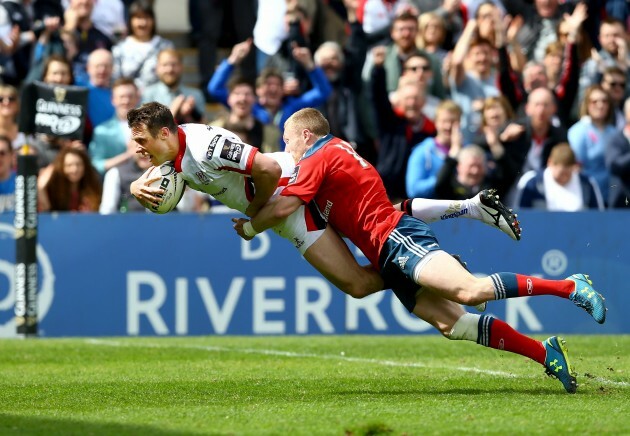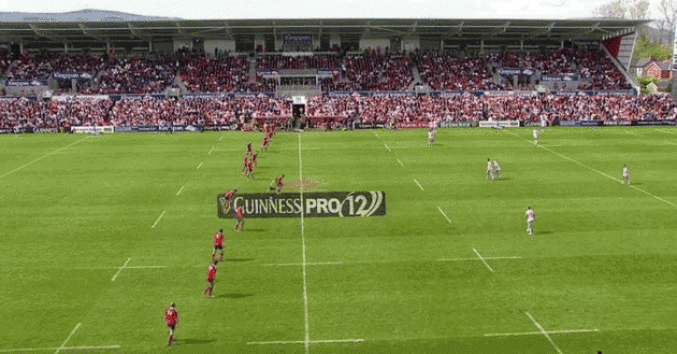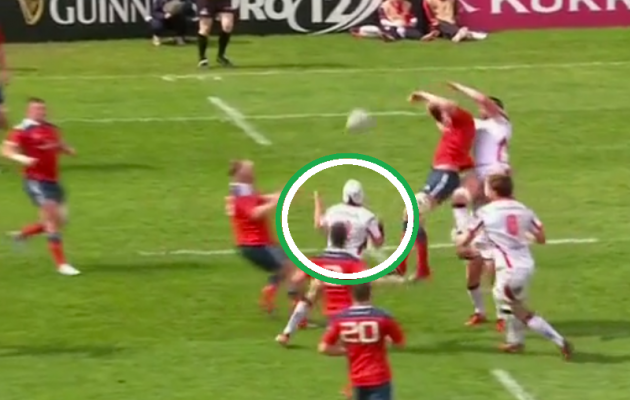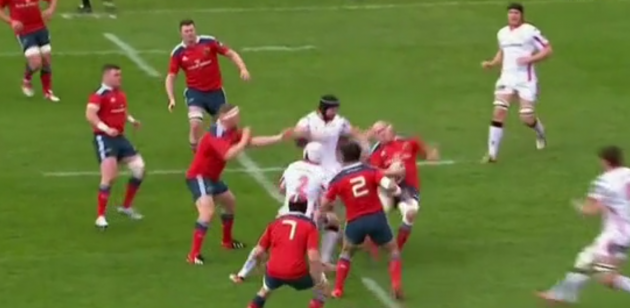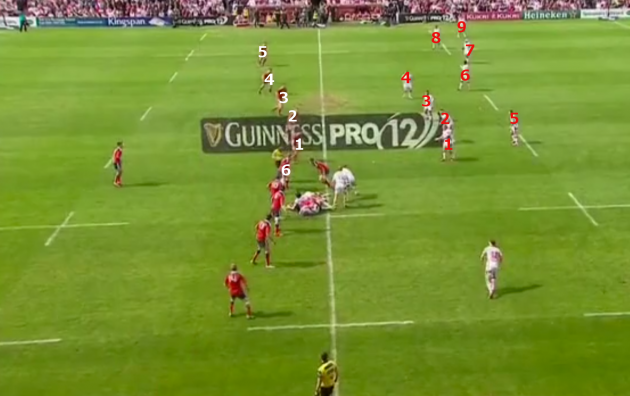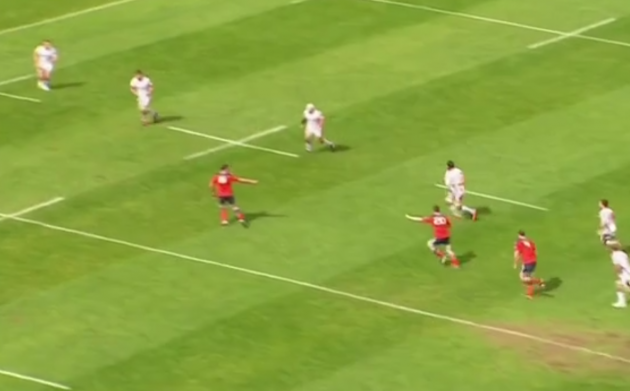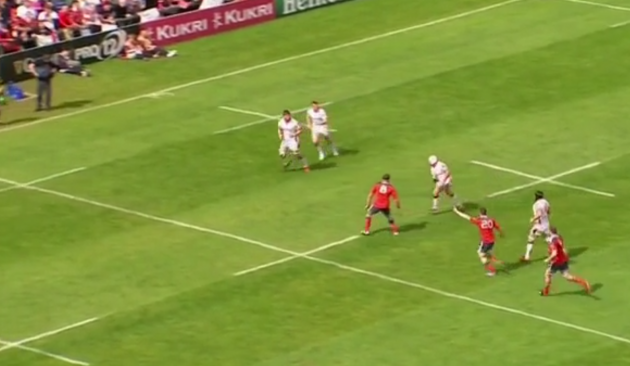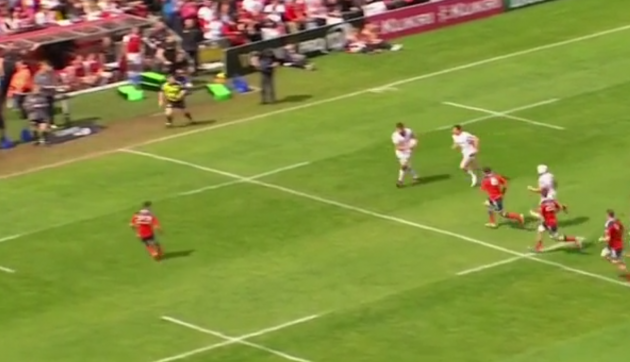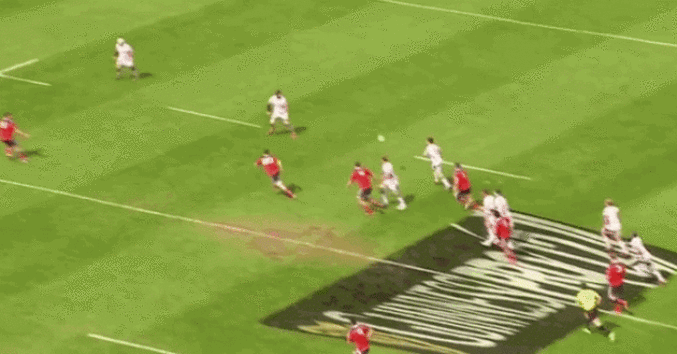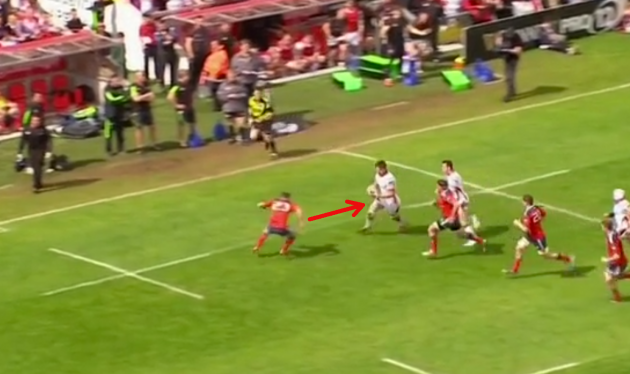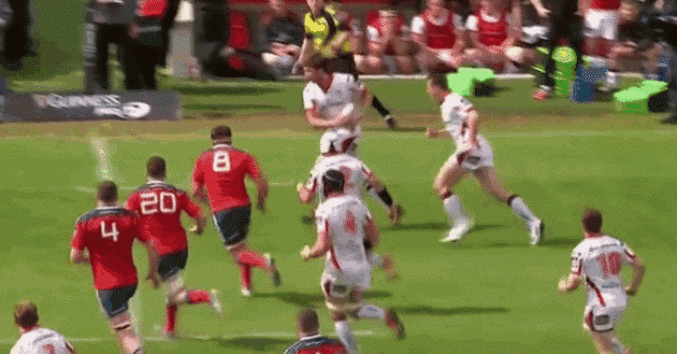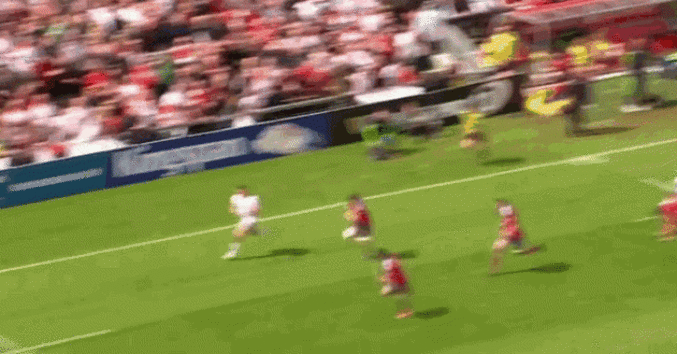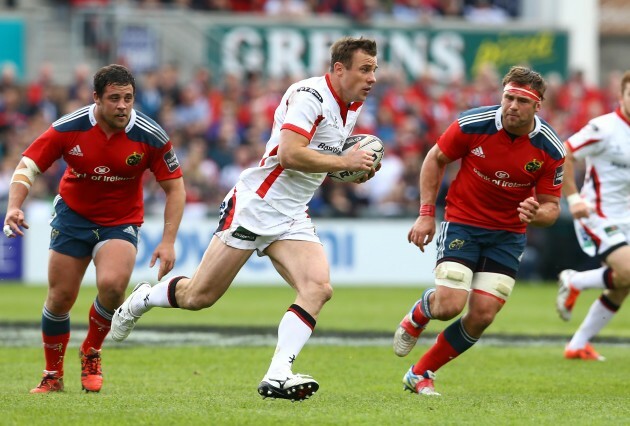MUNSTER COACH ANTHONY Foley pinpointed the “hiccups” at the end of both halves of his side’s 23-23 draw with Ulster as the main reason they didn’t grab an important away win in the Guinness Pro12 yesterday.
Indeed, Munster were leading 9-0 with two minutes of the first half remaining and then held a 23-16 advantage with two minutes of the second half left.
A draw in Kingspan Stadium is by no means a poor result, but Foley and his players will have been frustrated by the failure to close out both halves of the game in a solid manner. Ultimately, those lapses cost them what would have been an impressive win.
It takes two to tango, however, and obviously Ulster deserve major credit for the attacking thrusts which brought two tries in those decisive periods of the game.
Today, we take a look at both try-scoring incidents in order to learn what Munster could have done better and what Ulster got right.
Bowe’s beauty
Restarts are a crucial part of top-level rugby and we got the latest demonstration of that just before Tommy Bowe’s magnificent try in the first half.
With Paddy Jackson having converted a penalty to bring Ulster back to 9-3 [that score partly coming from a brilliant chase and hit by Iain Henderson from a restart after Munster had gone 9-0 ahead], Munster were handed the next restart.
As with the very first kick-off of the game, Ian Keatley dropped a short restart just over Ulster’s 10-metre line for Paul O’Connell to chase.
The kick is excellent from Keatley and O’Connell chases well, getting in underneath the ball as it crosses that 10-metre line. However, having caught the first kick-off cleanly, O’Connell can only slap this one back on Munster’s side as Dan Tuohy competes.
Ulster captain Rory Best shows typical intelligence to be in exactly the right place to gather in O’Connell’s tap back.
Best is able to pick off the ball and surge right up to the halfway line with a lack of defenders in front of him, the Munster forwards having been busy chasing the restart from Keatley.
It’s not a coincidence that Best is in this excellent position. If we jump back to that first restart of the game [below], we can see the Ulster hooker in a similar location as O’Connell wins the ball.
Good habits are good habits even when they don’t obviously stand out as good habits.
Best’s diligence secures possession for Ulster, brings them to the halfway line and then allows them to play away to the left through a short Chris Henry carry and then another from Louis Ludik off a sharp Paddy Jackson pass.
We’re getting a slight sense of the risk of short restarts in this instance. Shorter restarts can bring major benefits, as for O’Connell’s reclaim of the kick-off that allowed Munster to threaten with ball in hand early in the game.
We’re big fans of short restarts at The42, but they come with risks included and in this case Munster are forced to immediately retreat and switch into defensive mode. They might ponder whether a long restart and pressure on Ulster in the home side’s 22 might have been a better option in these circumstances.
As it is, Ulster take them through a pair of phases with Henry and Ludik’s carries, before they strike with a wonderfully slick attack involving backs and forwards combining perfectly.
Ulster had many excellent phase-play attacks like this one throughout the first half in particular, with out-half Paddy Jackson justifiably feeling they had left three further try-scoring chances untaken.
This time, the slickness of their attack beings the desired result in outstanding fashion.
The link pass we see above from Robbie Diack is a vital element, as it draws Munster’s defenders into a presumed contact point and then shifts the ball out the back door and along the line.
The vast majority of professional and good amateur teams across the rugby world use this very shape or a variation on it, as it’s an excellent way of drawing in defenders closer to the ruck to create space on the outside edge.
Jackson deserves credit too for simply shifting the ball on to Tuohy at an early stage. The Ulster out-half did this well all game, also managing to attack the line himself when that was the stronger option.
The hugely in-form Jackson is assessing space superbly at the moment and here he recognises that the opportunity is wide on the right. Move it on.
It’s worth taking a look at Munster’s defensive set up as Ulster are moving the ball wide to the right.
Above, we see the numbers on both sides as the phase begins. Ulster have nine players to the right of scrum-half Ruan Pienaar, while Munster have six men in their front-line defence on that left side of the ruck.
Conor Murray is sweeping behind the defence while left wing Ronan O’Mahony is in a deep position covering the backfield wide on the left.
It’s not the worst defensive scenario ever, but Munster will have to ask whether they could have got an additional body over to the left side of the ruck. Look at the image above again and we can see Foley’s men are over-stacked on the right side of the ruck, with three defenders faced by a single Ulster attacker.
With O’Connell having competed for the ball at the ruck following Ludik’s carry [Jared Payne clearing him with an effective croc roll], there was some time and scope for one of these players to ‘fold’ across to the other side, but it doesn’t happen in this instance.
It’s not quite a major breakdown in the system, and Munster will feel they still should have prevented Ulster from scoring.
What happens next for Munster is crucial, as they opt to rush up hard on the inside of their defensive line, prop Dave Kilcoyne leading them up. This is not something that goes against Munster’s normal approach but there are times when easing off the linespeed is suitable.
Was Kilcoyne being fed information from those outside him to let him know Ulster had big numbers holding width? Was he being told, ‘Ease off Killer, no hammer, no hammer’?
Munster managed to pressure Ulster superbly at times in this game with their linespeed and have done the same to other teams, but they might question whether rushing up close to the ruck was ideal here. Could they have sat back just a little more and therefore covered more ground laterally as they wedged out to the left touchline?
The combination of a rapid Pienaar pass and then Diack’s clever link play mean that by the time Jackson puts the ball into Tuohy’s hands, they’ve skirted outside the first four Munster defenders.
Munster are left with the above situation in their front-line defence, Jack O’Donoghue [20] and CJ Stander [8] faced with four Ulstermen looking to exploit the space on that outside edge.
Munster still have O’Mahony deep on the left and ready to join the line if and when the ball gets to the outside, so it’s not as dire a scenario as it might immediately look in the image above.
O’Donoghue and Stander want to cover at least three of the Ulster attackers here with their drift defence, allowing O’Mahony to take last man, and we can see O’Donoghue indicating to Stander that he has ball carrier Tuohy, telling the number eight to worry about the next Ulster attacker [Rory Best].
Tuohy shifts the ball on to Best and O’Donoghue has stayed active inside Stander, as we can again make out in the screenshot above.
Naturally enough, Stander is concerned by the threat of Best and he briefly hovers on the Ulster hooker. We can see that O’Donoghue is urging Stander to drift out again onto Henderson, presumably providing a vocal cue as well.
O’Donoghue wants Stander to shift out earlier, but anyone who’s been in this situation knows how difficult it is for Stander just to drift out and leave Best.
The split-second hesitation means that when Best then moves the ball into Henderson’s hands, the Ulster blindside has space to surge into on Stander’s outside shoulder.
The South African does recover to get back on the drift and get his hands on Henderson, but the ideal situation was that Stander could have completed the tackle on the Ulsterman unassisted.
Perhaps he could have, but we’ll never know as O’Mahony opted to enter contact and tackle Henderson. At the exact moment the Munster wing decides to make the hit, there is no extra man on the outside for Ulster.
As we see above, Bowe hasn’t yet shown on the outside of Henderson, so O’Mahony makes the decision to tackle Henderson. Could he have done otherwise? It would have been an exceptional read to identify the possible threat of Bowe and sit off, while there was also no guarantee that Stander would complete the tackle on Henderson.
As we suggested earlier, there are two sides to almost every play in a rugby game and that’s vitally important here. Henderson’s brilliance exploits the cracks in Munster’s defence to an extreme level and creates the score for Ulster.
Henderson knows exactly what he’s going to do here well before he enters contact. He makes no attempt to get to the outside of O’Mahony or fend the Munster wing; his intention is to tie both Stander and O’Mahony into the tackle.
Henderson slows ever so slightly as he runs at O’Mahony’s inside shoulder, ensuring that Stander can indeed get his hands on the Ulsterman. While that’s happening, Henderson also shifts the ball exclusively into his right hand and frees his left arm to provide something of a shield against Stander’s attempt to wrap high around the ball.
It’s brilliantly calculated by Henderson, who gets a vital shout from Bowe as the Ulster wing drifts to his teammate’s right shoulder and then the execution of the offload is sublime.
Bowe is freed to get rapidly up to full speed and his finish is equally as impressive.
As with every other coin in rugby, there are two sides to this one. We can focus on Bowe’s attacking excellence or the failure from Munster’s covering defenders.
The Ireland wing’s ability to change direction at quite a sharp angle to burst back onto the inside of Felix Jones is stunning, as is the powerful stride he produces to hitch through the tackle.
Murray has managed to get across from that original sweeping position at the start of the phase and will have expected to do better here, but part of the issue is that the Munster scrum-half slows his run when Henderson enters contact.
Murray is clearly not expecting the wondrous offload from Henderson and slows right down, before having to turn on the acceleration to get across to Bowe. Too late, as he manages to get a hand on the Ulster wing, but slams into teammate Jones simultaneously.
Jones is one of the finest cover-tackling fullbacks in Europe so he will have been equally frustrated not to halt Bowe. It’s that superb change of direction from the Ireland wing that does for Jones, who is attempting to shepherd Bowe towards the touchline.
Instead, Bowe drives back inside and Jones can’t connect a shoulder with the rapid-moving Ulsterman. His tackle attempt is all arms and the collision with Murray doesn’t help matters either.
Frustration and delight
“When I got up out of my seat to go down we were six points up and when I arrived we were one point down,” said Munster coach Foley of his trip down to the changing room just before the half-time break.
Clearly, there are areas where Munster will look at themselves as being culpable in defence, but we must give balancing amounts of credit to the attack for this try.
Best’s restart intelligence, carries from Henry and Ludik, Payne’s croc roll, Diack’s link pass, Jackson’s early release, the handling of Best and Tuohy, Henderson’s intellect and offload and Bowe’s supreme finish are equally as relevant as Munster’s numbering, linespeed selection, drifting, biting in and missed tackles.
We’ll take a close look at Ulster’s dramatic late try to secure a draw with Munster in a separate piece tomorrow on The42.
